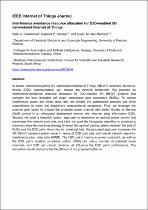 ResearchSpace
ResearchSpace
Interference avoidance resource allocation for D2D-enabled 5G narrowband Internet of Things
JavaScript is disabled for your browser. Some features of this site may not work without it.
- ResearchSpace
- →
- Research Publications/Outputs
- →
- Journal Articles
- →
- View Item
| dc.contributor.author |
Gbadamosi, SA

|
|
| dc.contributor.author |
Hancke, GP

|
|
| dc.contributor.author |
Abu-Mahfouz, Adnan MI

|
|
| dc.date.accessioned | 2023-04-17T06:11:37Z | |
| dc.date.available | 2023-04-17T06:11:37Z | |
| dc.date.issued | 2022-11 | |
| dc.identifier.citation | Gbadamosi, S., Hancke, G. & Abu-Mahfouz, A.M. 2022. Interference avoidance resource allocation for D2D-enabled 5G narrowband Internet of Things. <i>IEEE Internet of Things Journal, 9(22).</i> http://hdl.handle.net/10204/12745 | en_ZA |
| dc.identifier.issn | 2327-4662 | |
| dc.identifier.issn | 2372-2541 | |
| dc.identifier.uri | DOI: 10.1109/JIOT.2022.3184959 | |
| dc.identifier.uri | http://hdl.handle.net/10204/12745 | |
| dc.description.abstract | In dense, interference-prone 5G narrowband Internet of Things (NB-IoT) networks, device-to-device (D2D) communication can reduce the network bottleneck. We propose an interference-avoidance resource allocation for D2D-enabled 5G NB-IoT systems that consider the less favorable cell edge narrowband user equipment (NUEs). To reduce interference power and boost data rate, we divided the optimization problem into three subproblems to lower the algorithm’s computational complexity. First, we leverage the channel gain factor to choose the probable reuse channel with better Quality of Service (QoS) control in an orthogonal deployment method with channel state information (CSI). Second, we used a bisection search approach to determine an optimal power control that maximizes the network sum rate, and third, we used the Hungarian algorithm to construct a maximum bipartite matching strategy to select the optimal pairing pattern between the sets of NUEs and the D2D pairs. According to numerical data, the proposed approach increases the 5G NB-IoT system’s performance in terms of D2D sum rate and overall network signal-to-interference plus noise ratio (SINR). The D2D pair’s maximum power constraint, as well as the D2D pair’s location, pico-base station (PBS) cell radius, number of potential reuse channels, and D2D pair cluster distance, all influence the D2D pair’s performance. The simulation results demonstrate the efficacy of our proposed scheme. | en_US |
| dc.format | Abstract | en_US |
| dc.language.iso | en | en_US |
| dc.relation.uri | https://ieeexplore.ieee.org/document/9802636 | en_US |
| dc.source | IEEE Internet of Things Journal, 9(22) | en_US |
| dc.subject | 5G | en_US |
| dc.subject | Channel gain factor | en_US |
| dc.subject | Device-to-device | en_US |
| dc.subject | D2D | en_US |
| dc.subject | Interference avoidance | en_US |
| dc.subject | Narrowband Internet of Things | en_US |
| dc.subject | NB-IoT | en_US |
| dc.subject | Resource allocation | en_US |
| dc.title | Interference avoidance resource allocation for D2D-enabled 5G narrowband Internet of Things | en_US |
| dc.type | Article | en_US |
| dc.description.pages | 22752-22764 | en_US |
| dc.description.note | 2022 IEEE. Due to copyright restrictions, the attached PDF file only contains the abstract of the full-text item. For access to the full-text item, please consult the publisher's website: https://ieeexplore.ieee.org/document/9802636 | en_US |
| dc.description.cluster | Next Generation Enterprises & Institutions | en_US |
| dc.description.impactarea | EDT4IR Management | en_US |
| dc.identifier.apacitation | Gbadamosi, S., Hancke, G., & Abu-Mahfouz, A. M. (2022). Interference avoidance resource allocation for D2D-enabled 5G narrowband Internet of Things. <i>IEEE Internet of Things Journal, 9(22)</i>, http://hdl.handle.net/10204/12745 | en_ZA |
| dc.identifier.chicagocitation | Gbadamosi, SA, GP Hancke, and Adnan MI Abu-Mahfouz "Interference avoidance resource allocation for D2D-enabled 5G narrowband Internet of Things." <i>IEEE Internet of Things Journal, 9(22)</i> (2022) http://hdl.handle.net/10204/12745 | en_ZA |
| dc.identifier.vancouvercitation | Gbadamosi S, Hancke G, Abu-Mahfouz AM. Interference avoidance resource allocation for D2D-enabled 5G narrowband Internet of Things. IEEE Internet of Things Journal, 9(22). 2022; http://hdl.handle.net/10204/12745. | en_ZA |
| dc.identifier.ris | TY - Article AU - Gbadamosi, SA AU - Hancke, GP AU - Abu-Mahfouz, Adnan MI AB - In dense, interference-prone 5G narrowband Internet of Things (NB-IoT) networks, device-to-device (D2D) communication can reduce the network bottleneck. We propose an interference-avoidance resource allocation for D2D-enabled 5G NB-IoT systems that consider the less favorable cell edge narrowband user equipment (NUEs). To reduce interference power and boost data rate, we divided the optimization problem into three subproblems to lower the algorithm’s computational complexity. First, we leverage the channel gain factor to choose the probable reuse channel with better Quality of Service (QoS) control in an orthogonal deployment method with channel state information (CSI). Second, we used a bisection search approach to determine an optimal power control that maximizes the network sum rate, and third, we used the Hungarian algorithm to construct a maximum bipartite matching strategy to select the optimal pairing pattern between the sets of NUEs and the D2D pairs. According to numerical data, the proposed approach increases the 5G NB-IoT system’s performance in terms of D2D sum rate and overall network signal-to-interference plus noise ratio (SINR). The D2D pair’s maximum power constraint, as well as the D2D pair’s location, pico-base station (PBS) cell radius, number of potential reuse channels, and D2D pair cluster distance, all influence the D2D pair’s performance. The simulation results demonstrate the efficacy of our proposed scheme. DA - 2022-11 DB - ResearchSpace DP - CSIR J1 - IEEE Internet of Things Journal, 9(22) KW - 5G KW - Channel gain factor KW - Device-to-device KW - D2D KW - Interference avoidance KW - Narrowband Internet of Things KW - NB-IoT KW - Resource allocation LK - https://researchspace.csir.co.za PY - 2022 SM - 2327-4662 SM - 2372-2541 T1 - Interference avoidance resource allocation for D2D-enabled 5G narrowband Internet of Things TI - Interference avoidance resource allocation for D2D-enabled 5G narrowband Internet of Things UR - http://hdl.handle.net/10204/12745 ER - | en_ZA |
| dc.identifier.worklist | 26405 | en_US |





